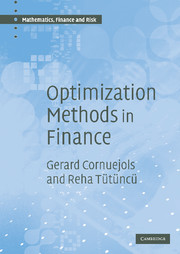Book contents
- Frontmatter
- Contents
- Foreword
- 1 Introduction
- 2 Linear programming: theory and algorithms
- 3 LP models: asset/liability cash-flow matching
- 4 LP models: asset pricing and arbitrage
- 5 Nonlinear programming: theory and algorithms
- 6 NLP models: volatility estimation
- 7 Quadratic programming: theory and algorithms
- 8 QP models: portfolio optimization
- 9 Conic optimization tools
- 10 Conic optimization models in finance
- 11 Integer programming: theory and algorithms
- 12 Integer programming models: constructing an index fund
- 13 Dynamic programming methods
- 14 DP models: option pricing
- 15 DP models: structuring asset-backed securities
- 16 Stochastic programming: theory and algorithms
- 17 Stochastic programming models: Value-at-Risk and Conditional Value-at-Risk
- 18 Stochastic programming models: asset/liability management
- 19 Robust optimization: theory and tools
- 20 Robust optimization models in finance
- Appendix A Convexity
- Appendix B Cones
- Appendix C A probability primer
- Appendix D The revised simplex method
- References
- Index
12 - Integer programming models: constructing an index fund
Published online by Cambridge University Press: 06 July 2010
- Frontmatter
- Contents
- Foreword
- 1 Introduction
- 2 Linear programming: theory and algorithms
- 3 LP models: asset/liability cash-flow matching
- 4 LP models: asset pricing and arbitrage
- 5 Nonlinear programming: theory and algorithms
- 6 NLP models: volatility estimation
- 7 Quadratic programming: theory and algorithms
- 8 QP models: portfolio optimization
- 9 Conic optimization tools
- 10 Conic optimization models in finance
- 11 Integer programming: theory and algorithms
- 12 Integer programming models: constructing an index fund
- 13 Dynamic programming methods
- 14 DP models: option pricing
- 15 DP models: structuring asset-backed securities
- 16 Stochastic programming: theory and algorithms
- 17 Stochastic programming models: Value-at-Risk and Conditional Value-at-Risk
- 18 Stochastic programming models: asset/liability management
- 19 Robust optimization: theory and tools
- 20 Robust optimization models in finance
- Appendix A Convexity
- Appendix B Cones
- Appendix C A probability primer
- Appendix D The revised simplex method
- References
- Index
Summary
This chapter presents several applications of integer linear programming: combinatorial auctions, the lockbox problem, and index funds. We also present a model of integer quadratic programming: portfolio optimization with minimum transaction levels.
Combinatorial auctions
In many auctions, the value that a bidder has for acquiring a set of items may not be the sum of the values that he has for acquiring the individual items in the set. It may be more or it may be less. Examples are equity trading, electricity markets, pollution right auctions, and auctions for airport landing slots. To take this into account, combinatorial auctions allow the bidders to submit bids on combinations of items.
Specifically, let M = {1, 2, …,m} be the set of items that the auctioneer has to sell. A bid is a pair Bj = (Sj, pj) where Sj ⊆ M is a nonempty set of items and pj is the price offer for this set. Suppose that the auctioneer has received n bids B1, B2, …, Bn. How should the auctioneer determine the winners in order to maximize his revenue? This can be done by solving an integer program. Let xj be a 0,1 variable that takes the value 1 if bid Bj wins, and 0 if it looses.
- Type
- Chapter
- Information
- Optimization Methods in Finance , pp. 212 - 224Publisher: Cambridge University PressPrint publication year: 2006
- 1
- Cited by

